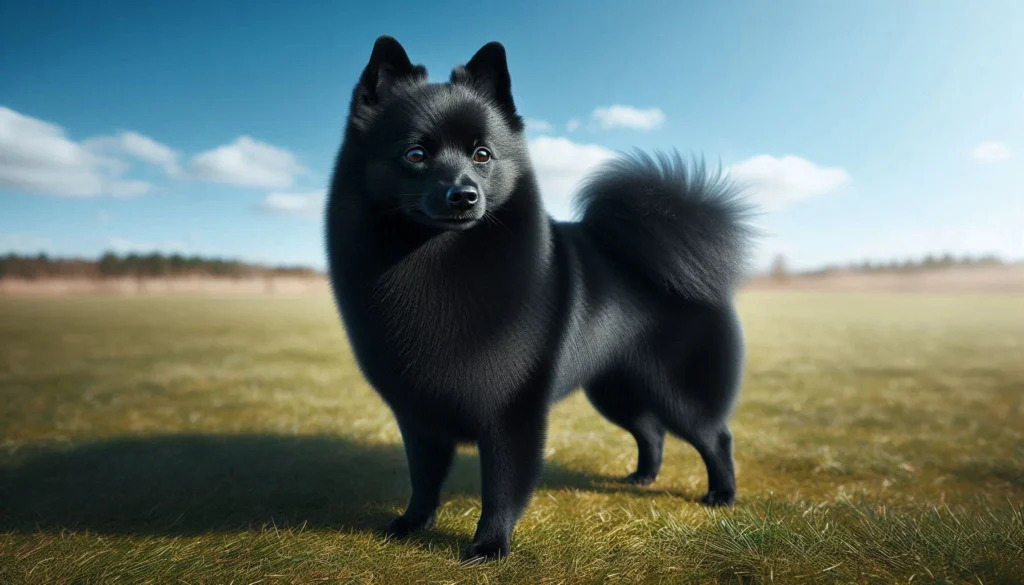Table of Contents
🐶 Schipperke Dog Breed: History, Characteristics and Care
The Schipperke dog breed, often affectionately referred to as the “little black devil,” is a small but mighty dog that has captured the hearts of dog owners worldwide. Known for their energetic nature, intelligence, and distinctive fox-like appearance, Schipperkes are a popular choice among those looking for a loyal and spirited companion. This article delves into the many facets of the Schipperke breed, exploring its history, physical characteristics, temperament, health, care requirements, training, and suitability as a family pet.
📜 Short History

The Schipperke dog breed hails from Belgium, where it has been cherished for centuries. The breed’s name is derived from the Flemish word “schip,” meaning “boat,” which highlights its original role as a watchdog on canal boats. These vigilant little dogs were tasked with guarding barges, earning them the nickname “little captain.”
The Schipperke’s history can be traced back to the 16th century when they were a common sight in the Belgian provinces of Antwerp and Brabant. They were bred by Belgian shoemakers who wanted a smaller version of the Leauvenaar, a larger working dog. The Schipperke’s reputation as an excellent ratter and watchdog quickly spread, earning them a place in both urban and rural settings.
In 1888, the Schipperke Club of Belgium was formed, solidifying the breed’s standard. The breed made its way to the United States in the early 20th century and was recognized by the American Kennel Club (AKC) in 1904. Today, the Schipperke continues to be a beloved companion known for its loyalty and versatility.
📌 Quick Facts & Essential Details

| Category 🏷️ | Details 📖 |
|---|---|
| 🐶 Breed Name | Schipperke |
| 📛 Other Names | Little Black Devil, Belgian Barge Dog |
| 📍 Origin | Belgium |
| 🏆 Recognized By | AKC, FCI, UKC, KC |
| 📏 Size Variants | Standard (No toy or miniature versions) |
| ⚖️ Weight Range | 10 – 16 lbs (4.5 – 7 kg) |
| 📐 Height Range | 10 – 13 inches (25 – 33 cm) |
| 🎂 Lifespan | 12 – 16 years |
🐕🦺 Coat & Appearance

| Category 🏷️ | Details 📖 |
|---|---|
| 🧥 Coat Type | Thick, dense double coat |
| 🎨 Coat Colors | Black (most common), but also found in Cream, Chocolate, and Blue (rare) |
⚡ Energy & Personality
| Category 🏷️ | Details 📖 |
|---|---|
| 🔋 Energy Level | High – Active and playful |
| 🏅 Breed Group | Non-Sporting Group |
| 🐾 Temperament | Curious, Fearless, Independent, Alert |
| 🏡 Apartment-Friendly? | Yes – Adapts well but needs regular exercise |
| 🎓 Trainability | Moderate – Intelligent but strong-willed |
🏥 Health & Care Needs

| Category 🏷️ | Details 📖 |
|---|---|
| 💉 Common Health Issues | Hip Dysplasia, Luxating Patella, Eye Disorders |
| 🛁 Grooming Needs | Moderate – Weekly brushing, more during shedding seasons |
| 🍂 Shedding Level | Moderate to High – Seasonal shedding |
| 🏃 Exercise Needs | High – Needs daily walks and mental stimulation |
🏡 Suitability & Compatibility

| Category 🏷️ | Details 📖 |
|---|---|
| 🏠 Best For | Active Individuals, Families, Apartment Dwellers |
| 🚫 Not Ideal For | Owners who prefer low-maintenance grooming |
| 🔊 Barking Level | High – Alert and vocal watchdog |
| 👶 Good With Kids? | Yes – Best with older children |
| 🐕 Good With Pets? | Yes – But may chase smaller animals |
| 👩🏫 First-Time Owner Friendly? | Yes – But requires patience in training |
| 🌡️ Weather Tolerance | Good in cold climates, sensitive to extreme heat |
🎉 Fun & Extra Info
| Category 🏷️ | Details 📖 |
|---|---|
| 🌟 Famous Dogs of This Breed | Often featured as mascots on Belgian canal boats |
| 🧠 Intelligence Level | High – Clever and quick learners |
| 🐕 Common Behavioral Issues | Stubbornness, Excessive Barking, Escape Artist Tendencies |
| 🥩 Best Diet | High-protein, small-breed kibble with lean meats |
| 🚫 Foods to Avoid | Chocolate, Grapes, Onions, Garlic, Excessive Fatty Foods |
| 🎈 Fun Fact | The Schipperke means “Little Captain” in Flemish, a nod to its history as a barge dog! |
| 💰 Price of Puppy | $1,000 – $2,500 (Depending on breeder & lineage) |
✅ Final Thoughts
The Schipperke is an energetic, intelligent, and independent companion dog known for its watchdog abilities and playful personality. With their bold spirit and high intelligence, they make great family pets for active owners. If you’re looking for a small but fearless dog with a lot of personality, the Schipperke might be the perfect choice! 🚢🐶
📊 Comparison of Similar Dog Breeds
🐶 Schipperke vs. Pomeranian 🦊


| Feature 🏆 | Schipperke ⚓🐕 | Pomeranian 🎀🐾 |
|---|---|---|
| 📍 Origin | Belgium | Germany / Poland |
| 🏅 Recognized By | AKC, FCI, UKC | AKC, FCI, UKC |
| 📏 Size Variants | Small | Toy |
| ⚖️ Weight Range | 10-16 lbs (4.5-7 kg) | 3-7 lbs (1.3-3.2 kg) |
| 📏 Height Range | 10-13 inches (25-33 cm) | 6-7 inches (15-18 cm) |
| ⏳ Lifespan | 12-16 years | 12-16 years |
| 🐶 Coat Type | Thick, double coat | Fluffy, double coat |
| 🎨 Coat Colors | Black (most common), cream, fawn, chocolate | Orange, black, cream, blue, chocolate, red, sable, merle |
| ⚡ Energy Level | High | Moderate to High |
| 🏡 Breed Group | Non-Sporting Group | Toy Group |
| 🔊 Barking Level | High (Alert & Vocal) | High (Watchdog tendencies) |
| 👶 Good With Kids? | Yes, best with older children | Yes, best with gentle handling |
| 🐕 Good With Pets? | Yes, but has a strong prey drive | Yes, friendly but can be bossy |
| 🧠 Intelligence Level | High (Quick Learner) | High (Eager to Learn) |
| ⚠️ Common Behavioral Issues | Stubbornness, escape artist, excessive barking | Prone to barking, can develop small dog syndrome |
| 💰 Price of Puppy | $1,000 – $2,500 | $1,500 – $5,000 |
| Overall Rating | ⭐⭐⭐⭐⭐ (Loyal & Energetic) | ⭐⭐⭐⭐⭐ (Lively & Affectionate) |
Conclusion
In summary, the Schipperke dog breed is a lively, intelligent, and loyal companion that can bring joy and excitement to any household. With proper care, training, and socialization, Schipperkes can thrive in various living environments and make excellent family pets. If you’re looking for a small dog with a big personality, the Schipperke might be the perfect choice for you.
FAQ
Is the Schipperke a dangerous dog?
No, the Schipperke is not a dangerous dog. While they can be wary of strangers and protective of their families, they are generally friendly and affectionate with proper socialization and training.
Is the Schipperke the best guard dog to protect you or your family?
Schipperkes make excellent watchdogs due to their alertness and protective nature. However, they are small dogs and may not be the best choice for a guard dog role. They can alert you to potential threats but should not be relied upon for protection against intruders.


